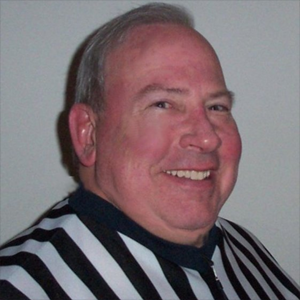
Rndballref
20 Years Experience
Chicago, IL
Male, 60
For twenty years I officiated high school, AAU and park district basketball games, retiring recently. For a few officiating is the focus of their occupation, while for most working as an umpire or basketball referee is an avocation. I started ref'ing to earn beer money during college, but it became a great way to stay connected to the best sports game in the universe. As a spinoff, I wrote a sports-thriller novel loosely based on my referee experiences titled, Advantage Disadvantage
If the player comes down with both hands on the ball it is double dribble. If the player has only one hand on top of the ball it is a dribble and he cannot dribble again.
If neither player is entitled to the air space where they collide, it should be treated as incidental contact, regardless of the severity of the impact.
Foul is on defensive player. Principle of vertical space.
Team control ends when the ball is in flight on a try or tap for a goal. Since there is no team control, there is no backcourt violation. Play on...
Starbucks Barista
 Why does Starbucks attract so many homeless people?
Why does Starbucks attract so many homeless people?
Emergency Room Manager
 What's the best time to arrive at an ER to avoid waits?
What's the best time to arrive at an ER to avoid waits?
Flight Attendant
 What kinds of passengers annoy you the most?
What kinds of passengers annoy you the most?
No, an offensive player cannot regain the ability to dribble until another player touches the ball WHILE the original player no longer possesses the ball. So if A1 has continuous possession during the time that B1 touches the ball, A1 cannot dribble for the second time. A more likely call is if B1 touches the ball and pushes it in an opposite direction than A1 is holding it, it should be called a held ball (and go to the possession arrow).
It is impossible to say or even generalize/ For example the University of Illinois, a D1 Big Ten school had scholarship player Nnanna Egwu who was born in Nigeria and didn't play basketball until 8th grade. He was considered a "project" when he was offers a scholarship. He had a good, not stellar collage career and he is trying to play pro ball but has of yet not hooked on with a team in the NBA. By the way, in college Nnanna played at 6 foot 9. The problem with being 6'2" and 165 lbs is not many schools will take on a "project" who hasn't played much ball. A lot depends on how much time a player has to develop and where the development takes place. Seems to me that most well recruited middle schoolers or even high schoolers play for very competitive AAU teams. If you want to be the best, you have to compete with the best.
You are correct. As soon as the technical foul is called the ball is dead, unless the shot has left a shooter's hands.
-OR-
 Login with Facebook
Login with Facebook (max 20 characters - letters, numbers, and underscores only. Note that your username is private, and you have the option to choose an alias when asking questions or hosting a Q&A.)
(A valid e-mail address is required. Your e-mail will not be shared with anyone.)
(min 5 characters)
By checking this box, you acknowledge that you have read and agree to Jobstr.com’s Terms and Privacy Policy.
-OR-
 Register with Facebook
Register with Facebook(Don't worry: you'll be able to choose an alias when asking questions or hosting a Q&A.)